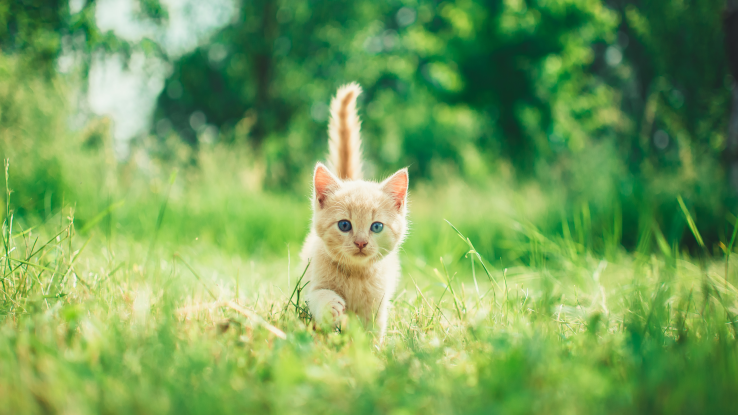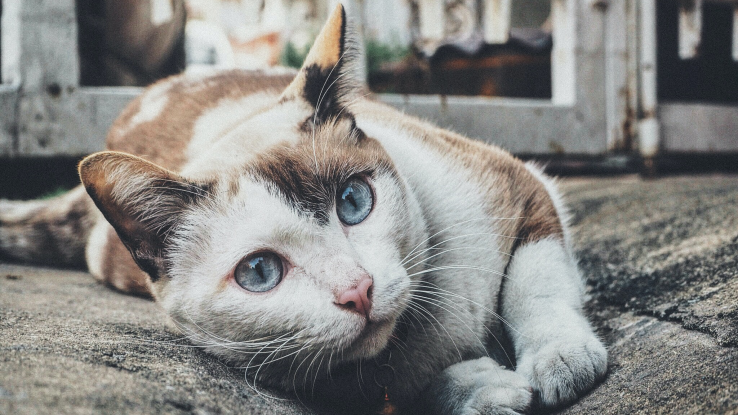I Have to Stop Feeding Stray Cats but I Am Afraid They Die of Hunger
If you recently adopted a kitten, you're probably wondering when you'll be able to tell that it has stopped growing. You want to know when it will grow up and what its maximum size is.
In short, every cat grows up differently. But on average, full maturity usually takes between one and four years. With that said, there are some metrics that can help you estimate when your cat has stopped growing. Here, we'll look at these methods to give you a better understanding of your cat.
The Stages of a Cat's Life

The average everyday cat grows to a height of about 18 inches. This is the measurement from their shoulder to paw. At full size, most cats weigh about ten pounds.
Breeds like Siamese and Tabby reach their full size in just one year. But regardless of how long it takes your cat to reach full size, there's a lot that goes in the in-between years.
Below, you will see the various stages of a cat's life and what takes place within them.
0 to 6 Months
This is the fastest growth stage. Your cat will go from a newborn kitten (with eyes closed and depending on their mother) to a lively and curious kitten. During this period, your kitten will be into everything, often becoming a nuisance and potentially tearing up things as it learns its capabilities.
Your kitten's weight will increase as rapidly as their curiosity. In the first few weeks, kittens gain between a quarter-pound and a half-pound every week! And they continue to do this until they double their birth weight at ten to 12 weeks.
This is also a time when socialization is essential. To prevent your kitten from becoming indifferent, it's crucial to provide a lot of interaction and affection. If you've ever come across a feral cat and experienced their aloof behavior, it's because they didn't have any social relationships with humans growing up. This also helps explain why they typically avoid people.
At the earlier stages of a kitten's life, they are usually incredibly fluffy and have big, round faces and large eyes. Their paws are generally reasonably big compared to the rest of their bodies.
Moreover, they have small but sharp teeth, and their bones are quite tiny. Younger kittens are also very active and a lot of fun — if not overly playful at times. Once they are about ten weeks old, kittens start losing their baby teeth. And by the time they reach six months, their adult teeth are grown in.
Facial features are also much more prominent, displaying a more sleek appearance. This usually happens anywhere between three and six months.
6 to 12 Months
At this stage, the growth rate of kittens will slow down. Most veterinarians consider kittens fully grown at one year old. Here, they can also transition from kitten food to adult cat food. However, depending on your cat's breed, they could still be in the process of growing and need to eat kitten food until they are about two years old.
You should have a pretty clear picture of what your kitten will look like as an adult when it hits this stage. A lot of tiny domestic cats cease to grow once they reach 12 to 16 months old. But larger cats, such as Ragdolls and Maine Coons, will keep growing all the way up to four and five years old.
In general, though, the round face of most kittens starts to become longer and more prominent, just like adult cats. It's here that you know your cat has reached adolescence.
You should expect a rebellious attitude with lots of energy that keeps them on the move. If your cat is one that likes to continuously run and explore, they will likely develop a very slender appearance. But as they get older, their body will grow into a more lanky frame.
It's also here that your cat will have reached full sexual maturity. As such, males can get females pregnant, and females can conceive. At this stage, your vet might recommend that you neuter or spay your kitten. If you decide against this, it's best to keep your kitten away from others to prevent mating.
1 to 3 Years
Congratulations; your cat is now an adult. You could still see some growth, but it will be very slow. By and large, most cats stop growing when they reach 1 ½ (18 months). However, your cat might still look fairly lean around this stage.
3 to 6 Years
Your cat is in the prime of their life. Bigger breeds might continue to grow for another one to two years. But smaller species should be fully grown at this point. Typical behavior includes playing with favorite toys, self-grooming, eating, and sleeping.
7 to 10 Years
In these years, your cat is fully matured. You're likely to see playfulness but with a more relaxed attitude towards life. Any growth will have stopped entirely at this point. The only possible growth you might notice is in the belly, and that's dependent on how often you feed your cat.
On that note, it's important to provide your cat with a healthy diet and plenty of exercise. In doing so, you can help prevent illnesses and diseases.
11 to 14 Years
Your cat is now considered a senior. As such, you should expect their mobility to slow down quite a bit. Furthermore, it's between these years that many diseases can develop due to your cat's older age.
15 and Up
You might start noticing your cat losing weight, often the result of age-related health problems. Fur sometimes starts looking less vibrant, as well. But even at this age, underneath the slowed behavior and laid-back demeanor, there's a cat who will still play if you engage it and is more than happy to jump up on your lap to cuddle (possibly with a little help).
Cats and Size

You may look at your kitten's paws and wonder if your cute furball will turn into a huge lion. But it's important to remember that a kitten is different from a puppy. And as such, paws are not a sign of maximum size when they grow up.
Instead, gender, breed, and various other factors play a role in how big your particular cat gets. Take a moment to examine these factors below so that you know what to expect from your feline.
Gender
Males tend to grow slower compared to females. But males will get a lot bigger than females, often as much as two pounds bigger. Moreover, it doesn't matter whether your cat is spayed or neutered. It will continue to grow just as it normally would.
The only difference that changes during these operations is the cat's metabolic rate. As a result, weight gain or loss might be more prominent depending on your cat's activity levels. A cat that prefers lazing about and sleeping will likely put on more weight and at a faster rate.
Genetics
This is one of those factors that can give you a clue as to how big your cat will grow to be. For example, if you take your kitten to the vet and abnormalities of any kind are discovered at an early age, it could mean that your kitty will grow to have dwarfism or a bone problem. These could cause your cat to be smaller as an adult.
It might help to check the health and medical history of the kitten's parents if it's at all possible. In doing so, you can see whether your kitten might be prone to becoming bigger or smaller as an adult cat.
Diet
This is a big one. When you provide your kitten with a healthy diet throughout their life, you can usually expect a healthy weight and size. The first years of a kitten's life are very important. As such, you should keep a close eye on what you feed them and try to maintain a balanced diet and exercise.
When you follow a healthy feeding schedule, you can usually look forward to your kitten growing up to be healthy, strong, and with a reasonable weight.
Full-Sized Felines
As with other pets, cats need a proper diet and lots of love. Once you know that your cat has stopped growing, you can help control its size by continuing with a healthy diet.
No matter what size your kitten grows to, with attention and care, your cat can live a happy life.
SOURCES:
Tabby Cat Facts | ASPCA Pet Insurance
Cat Care | Common Cat Diseases
Feeding Your Cat | Cornell University
At What Age Are Cats Fully Grown? | Pet MD
Source: https://www.reference.com/pets-animals/when-can-i-tell-my-cat-has-stopped-growing?utm_content=params%3Ao%3D740005%26ad%3DdirN%26qo%3DserpIndex&ueid=da3de919-562f-4cf5-8f77-f76828d082ea
0 Response to "I Have to Stop Feeding Stray Cats but I Am Afraid They Die of Hunger"
Post a Comment